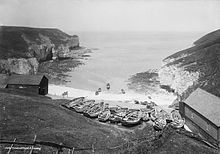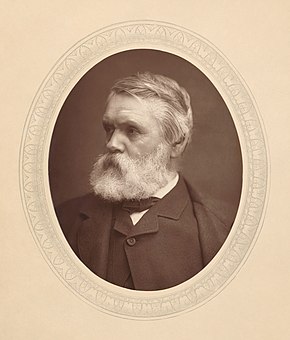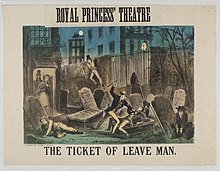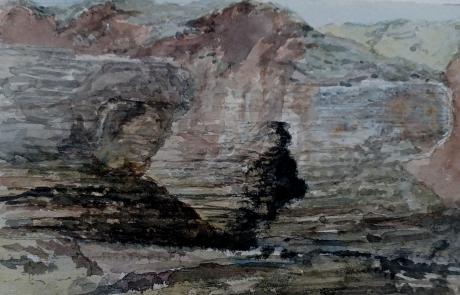signed with initials "TT"
Tom and Laura Taylor and thence by descent
Located on the north side of the magnificent Flamborough Headland. North Landing beach is a beautiful expanse of sand, white pebbles and rock pools. It is a perfect spot for a family day out where you can have a picnic.
The pretty coves of North Landing and Thornwick Bay are scattered with caves along the shoreline and are perfect for exploring. Ideal for rockpooling in the shallows, you definitely want to be bringing a net and bucket to see what creatures you can find. Set against the chalk cliffs, the beaches are pictureque and you can sit and watch the waves roll in after a day of exploring.
A popular beach, with toilets (closed during the winter), café restaurant/ bar and shop. A sandy bay, rock pools, caves and chalk cliffs. In the summer boat trips are available. This beach was part of the filmset for the Dad's Army film
Site of the old Lifeboat Station (now moved to South Landing), North Landing is still famous for its smugglers’ caves and panoramic views north along the coast to Filey and Scarborough. Once the hub of Flamborough’s small but active fishing industry, now a few cobles are all that remain. The secluded beach at Thornwick, on the Filey side of North Landing, is the perfect place to while away a summer’s afternoon.
Flamborough village is thought to have been colonized over 1,100 years ago by Scandinavians, and was referred to as "Fleneburg" in the Domesday Book (1086). Before this, there was also a Roman presence, which is evidenced by Beacon Hill, once the site of a Roman signal station. The village, cut off by the enormous defensive earthwork, erroneously called Dane's Dyke, still, to this day, has a distinctive character. Fishing was first recorded in the 13th century, when about nine boats fished the seas off the Head. By the 1890s, some eighty "cobles" were registered. Now, although some fishing is still carried on, the village relies to a greater extent on tourism. However, as the old postcards on this page demonstrate, Flamborough has always been a popular destination.
Standing in broad sunshine on the beach at North Landing, Flamborough, and watching the fishing boats come in, you would think there was nowhere more blissful and peaceful. People in shorts are strolling along the clifftop path, while the cliffs below are dotted with puffins and razorbills, most of them dozing in the warmth. Mike Emmerson, captain of the Summer Rose, is smiling. “We haven’t been out for two weeks because of the easterlies. Even today, you’d think it was flat calm from here, but there’s a swell. I wouldn’t take passengers in it.”
It is a reminder of how treacherous the Yorkshire coast can be. By one estimate, it has averaged two shipwrecks a week since 1500. In 1869, the 100-mile stretch of coast between Spurn Head and Teesmouth accounted for 838 ships – more than two a day. What few people realise is that many wrecks still survive, in some battered form, and can be visited. The coastal path is often walked, but few are aware of the lost and secret history that lies among the rocks and caves.
At North Landing, as low tide approaches, I set off along the rocks under the cliffs on the north side of the cove. At the point there is a large lump of rusting metal trapped in the rocks, a thing the size of a small car. It is the boiler of SS Rosa, an Admiralty ship that went down in 1930. Riveted steel plates are scattered about. Nearby are some wonderful sea caves to explore. (Always be absolutely sure of the tide times and heights, which change daily. An hour either side of low water is usually the best and only exploring time. Many sailors who survived wrecks died attempting to climb the cliffs.)
Heading back to the beach, I clamber across the rocks and enter a small cave right under a cacophony of seabirds on the chalk cliffs. Once my eyes are accustomed to the gloom, I make my way into a much larger cavern, like the digestive tract of an enormous sea monster. It leads down to an exit where the waves are breaking. This is Robin Lythe’s Cave, said to be named after a smuggler who used this magnificent cavern to land, and store, contraband.
At low tide, you can step out of the cave’s main seaward entrance and admire the cliffs of Flamborough Head, that notorious destroyer of shipping. Charles Dickens, touring the area’s graveyards in 1851, was moved to write: “You would imagine any man mad, from all that you see around you, who would think of trusting himself to the ocean.” By then, the shipwreck had become a relentless tragic narrative, with hymn-writers salting every lyric with wrathful tempests and harbours of salvation. More prosaically, the people of the coast gathered firewood and building materials galore: hire an old cottage along these shores and you’ll probably be sleeping under the timbers of a sailing-era shipwreck.
Flamborough’s most famous wreck has yet to be found: that of the American vessel Bonhomme Richard, which sank in 1779 in front of crowds of people on the cliffs. They had gathered to watch the ship battle it out with the British man of war, Serapis. Bizarrely, the Americans lost their ship, but boarded the Serapis and captured her in hand-to-hand combat.
The walk north to Bempton, via more caves at Thornwick Bay, is a wonderful one. As you approach the RSPB reserve, stop at New Roll-Up viewpoint: you might spot the remains of the Radium, an Italian ship wrecked in 1923.
Most wrecks here are exactly that – shattered remains. Up the coast near Robin Hood’s Bay, there is one that until relatively recently looked like a full ship. Local residents report that the wreck of the trawler Sarb-J has now broken up, however some parts are still there. Checking the tide, walk north along the rocky shoreline and you will come across Sarb-J, which ran aground here in 1994 after her propeller got tangled in rope. A big rescue effort ensued and the crew were airlifted off. It is now perched on its keel under the cliff.
Further up the coast at Saltwick Bay, a walk across the scars towards the rock known as Black Nab reveals another wreck, this one almost unrecognisable as a ship. In 1976, the Admiral von Tromp ran aground here in thick fog and heavy seas. The Whitby lifeboat got so close it touched, but the rescue proved difficult and two men drowned.
The shore at Kettleness, between Whitby and Runswick Bay, is scattered with wreckage, including the Wolfhound, a Humber boat that went down in 1896; the boiler is still there, covered in kelp. One wreck, the Belgian trawler Jeanne, is remembered in the churchyard at Lythe, where there is a gravestone for three men who drowned in 1932. (This atmospheric graveyard appears in Daniel Day Lewis’s next film, The Phantom Thread.)
The last stop in any shipwreck walk ought to be the evocative St Mary’s church in Whitby, where there is a memorial to the lifeboat tragedy of 1861. During a terrible storm, and after saving many lives in front of a massive crowd on the pier, the lifeboat flipped over, drowning 12 men. One crew member, Henry Freeman, survived. He had the sense to wear a newfangled life vest.
After visiting the church, head down the steps – known by all as the Dracula Steps – across the swing bridge and over to the pier itself, a fabulous piece of marine engineering. From there, continue up the hill towards East Terrace. On a grassy bank you will find a park bench dedicated to Bram Stoker, who sat here and used a real shipwreck – that of a Russian vessel on the shore opposite – to create an imaginary one, that of the Demeter, and, of course, the most memorable shipwreck survivor of all time: Count Dracula himself.
Flamborough Head (/ˈflæmbərə/) is a promontory, 8 miles (13 km) long on the Yorkshire coast of England, between the Filey and Bridlington bays of the North Sea. It is a chalk headland, with sheer white cliffs. The cliff top has two standing lighthouse towers, the oldest dating from 1669 and Flamborough Head Lighthouse built in 1806. The older lighthouse was designated a Grade II* listed building in 1952 and is now recorded in the National Heritage List for England, maintained by Historic England. The cliffs provide nesting sites for many thousands of seabirds, and are of international significance for their geology.
Flamborough Head has been designated a Special Area of Conservation (SAC) by the British Government's Joint Nature Conservation Committee (JNCC). (Special Areas of Conservation are strictly protected sites designated under the European Community Habitats Directive, which requires the establishment of a European network of important high-quality conservation sites to make a significant contribution to conserving the 189 habitat types and 788 species identified in Annexes to this Directive.) Flamborough Outer Headland is an 83 hectares (210 acres) Local Nature Reserve. Yorkshire Wildlife Trust manages the Flamborough Cliffs Nature Reserve, located on the headland.
The cliffs at Flamborough Head are designated a Site of Special Scientific Interest for both geological and biological significance. First designated in 1952, the SSSI area extends from Sewerby round the headland to Reighton Sands. The estimated 200,000 nesting seabirds, including one of only two mainland British gannetries, are the most notable biological feature.
![]()
Flamborough Head in the East Riding of Yorkshire
The headland is the only chalk sea cliff in the north. The coastline within the SSSI has strata from the upper Jurassic through to top of the Cretaceous period, and the headland exhibits a complete sequence of Chalk Group North Sea Basin strata, dated from 100 to 70 million years ago. The various chalk deposits are known as the Ferriby, Welton, Burnham and Flamborough Chalk. The dramatic white cliffs contrast with the low coast of Holderness to the south, where the chalk is deeply buried and the glacial boulder clay above erodes very readily. The chalk cliffs have a larger number and a wider range of cave habitats at Flamborough than at any other chalk site in Britain, the largest of which are known to extend for more than 50 metres from their entrance on the coast. There are also stacks, natural arches and blowholes. The site is identified as being of international importance in the Geological Conservation Review.

Seabirds such as northern gannets, kittiwakes and Atlantic puffins breed abundantly on the cliffs. Bempton Cliffs, on the north side of the headland, has an RSPB reserve and visitor centre.
The shooting of seabirds at Flamborough Head was condemned by Professor Alfred Newton in his 1868 speech to the British Association for the Advancement of Science. Local MP Christopher Sykes introduced the Sea Birds Preservation Act 1869, the first Act to protect wild birds in the United Kingdom. Shooting continued, with an 1886 edition of The Cornishman newspaper reporting the enormous flocks of sea birds are affording sport, with the fisherman killing the birds for selling to taxidermists; two boatmen were bagging a hundred birds daily.
Because it projects into the sea, Flamborough Head attracts many migrant birds in autumn, and is a key point for observing passing seabirds. When the wind is in the east, many birders watch for seabirds from below the lighthouse, or later in the autumn comb the hedges and valleys for landbird migrants. Flamborough Head has a bird observatory.
A Franco-American squadron fought the Battle of Flamborough Head with a pair of Royal Navy frigates in the American Revolutionary War on 23 September 1779. In the engagement, USS Bonhomme Richard and Pallas, with USS Alliance, captured HMS Serapis and HM hired armed ship Countess of Scarborough, the best-known incident of Captain John Paul Jones's naval career. The toposcope at the lighthouse commemorates the 180th (1959) anniversary of the battle.

Danes Dyke is a 2-mile (3.2 km) long ditch that runs north to south isolating the seaward 5 square miles (13 km2) of the headland. The dyke and the steep cliffs make the enclosed territory and its two boat launching beaches, North and South Landings, easily defended. Despite its name, the dyke is prehistoric in origin, and Bronze Age arrowheads were found when it was excavated by Pitt-Rivers in 1879. It is a Local Nature Reserve.
On the north side of Flamborough Head lies Thornwick Bay, a bay with a rock beach surrounded by cliffs. The second part of the name Thornwick comes from the Old Norse word vík ('bay') (meaning that the modern name Thornwick Bay is tautologous). At the north side of the bay lies Thornwick Nebb, the final part of which comes from Old Norse neb ('promontory').
A plaque at Thornwick Bay commemorates the 1952 loss of Robert Redhead, the bowman of the Bridlington lifeboat, while attempting to rescue two girls, Joan Ellis and Gillian Fox, from drowning.
Flamborough Head and the village of Flamborough are the setting for the book Bill Takes the Helm by Betty Bowen. In the book an American boy struggles to save his grandmother's house – in which he, his sister and grandmother are living – from destruction by the sea. He is also desperately trying to get used to England after the death of his mother, who requested in her will that he be sent there.
Flamborough Head was featured on the television programme Seven Natural Wonders as one of the wonders of Yorkshire and briefly in the first series of Coast.
Flamborough Head was featured in the finale of series 3 of the ITV drama Scott & Bailey.
North Landing beach was used as a film location for the 2016 re-make of Dad's Army.
During the evening of 23 August 2006, a lightning bolt hit a buttress on the cliffs, sending 100 tonnes of rock into the sea.

Tom Taylor (19 October 1817 – 12 July 1880) was an English dramatist, critic, biographer, public servant, and editor of Punch magazine. Taylor had a brief academic career, holding the professorship of English literature and language at University College, London in the 1840s, after which he practised law and became a civil servant. At the same time he became a journalist, most prominently as a contributor to, and eventually editor of Punch.
In addition to these vocations, Taylor began a theatre career and became best known as a playwright, with up to 100 plays staged during his career. Many were adaptations of French plays, but these and his original works cover a range from farce to melodrama. Most fell into neglect after Taylor's death, but Our American Cousin (1858), which achieved great success in the 19th century, remains famous as the piece that was being performed in the presence of Abraham Lincoln when he was assassinated in 1865.
Early years
Taylor was born into a newly wealthy family at Bishopwearmouth, a suburb of Sunderland, in north-east England. He was the second son of Thomas Taylor (1769–1843) and his wife, Maria Josephina, née Arnold (1784–1858). His father had begun as a labourer on a small farm in Cumberland and had risen to become co-owner of a flourishing brewery in Durham. After attending the Grange School in Sunderland, and studying for two sessions at the University of Glasgow, Taylor became a student of Trinity College, Cambridge in 1837, was elected to a scholarship in 1838, and graduated with a BA in both classics and mathematics. He was elected a fellow of the college in 1842 and received his MA degree the following year.

Taylor left Cambridge in late 1844 and moved to London, where for the next two years he pursued three careers simultaneously. He was professor of English language and literature at University College, London, while at the same time studying to become a barrister, and beginning his life's work as a writer. Taylor was called to the bar of the Middle Temple in November 1846. He resigned his university post, and practised on the northern legal circuit until he was appointed assistant secretary of the Board of Health in 1850. On the reconstruction of the board in 1854 he was made secretary, and on its abolition in 1858 his services were transferred to a department of the Home Office, retiring on a pension in 1876.
Writer
Taylor owed his fame and most of his income not to his academic, legal or government work, but to his writing. Soon after moving to London, he obtained remunerative work as a leader writer for the Morning Chronicle and the Daily News. He was also art critic for The Times and The Graphic for many years. He edited the Autobiography of B. R. Haydon (1853), the Autobiography and Correspondence of C. R. Leslie, R.A. (1860) and Pen Sketches from a Vanished Hand, selected from papers of Mortimer Collins, and wrote Life and Times of Sir Joshua Reynolds (1865). With his first contribution to Punch, on 19 October 1844, Taylor began a thirty-six year association with the magazine, which ended only with his death. During the 1840s he wrote on average three columns a month; in the 1850s and 1860s this output doubled. His biographer Craig Howes writes that Taylor's articles were generally humorous commentary or comic verses on politics, civic news, and the manners of the day. In 1874 he succeeded Charles William Shirley Brooks as editor.
Taylor also established himself as a playwright and eventually produced about 100 plays. Between 1844 and 1846, the Lyceum Theatre staged at least seven of his plays, including extravanzas written with Albert Smith or Charles Kenney, and his first major success, the 1846 farce To Parents and Guardians. The Morning Post said of that piece, "The writing is admirable throughout – neat, natural and epigrammatic". It was as a dramatist that Taylor made the most impression – his biographer in the Dictionary of National Biography (DNB) wrote that in writing plays Taylor found his true vocation. In thirty-five years he wrote more than seventy plays for the principal London theatres.

A substantial portion of Taylor's prolific output consisted of adaptations from the French or collaborations with other playwrights, notably Charles Reade. Some of his plots were adapted from the novels of Charles Dickens or others. Many of Taylor's plays were extremely popular, such as Masks and Faces, an extravaganza written in collaboration with Reade, produced at the Haymarket Theatre in November 1852. It was followed by the almost equally successful To Oblige Benson (Olympic Theatre, 1854), an adaptation from a French vaudeville. Others mentioned by the DNB are Plot and Passion (1853), Still Waters Run Deep (1855) and The Ticket-of-Leave Man (based on Le Retour de Melun by Édouard Brisebarre and Eugène Nus), a melodrama produced at the Olympic in 1863.Taylor also wrote a series of historical dramas (many in blank verse), including The Fool’s Revenge (1869), an adaption of Victor Hugo's Le roi s'amuse (also adapted by Verdi as Rigoletto), 'Twixt Axe and Crown (1870), Jeanne d'arc (1871), Lady Clancarty (1874) and Anne Boleyn (1875). The last of these, produced at the Haymarket in 1875, was Taylor's penultimate piece and only complete failure. In 1871 Taylor supplied the words to Arthur Sullivan's dramatic cantata, On Shore and Sea.
Like his colleague W. S. Gilbert, Taylor believed that plays should be readable as well as actable; he followed Gilbert in having copies of his plays printed for public sale. Both authors did so at some risk, because it made matters easy for American pirates of their works in the days before international copyright protection. Taylor wrote, "I have no wish to screen myself from literary criticism behind the plea that my plays were meant to be acted. It seems to me that every drama submitted to the judgment of audiences should be prepared to encounter that of readers".

Many of Taylor's plays were extremely popular, and several survived into the 20th century, although most are largely forgotten today. His Our American Cousin (1858) is now remembered chiefly as the play Abraham Lincoln was attending when he was assassinated, but it was revived many times during the 19th century with great success. It became celebrated as a vehicle for the popular comic actor Edward Sothern, and after his death, his sons, Lytton and E. H. Sothern, took over the part in revivals.
Howes records that Taylor was described as "of middle height, bearded [with] a pugilistic jaw and eyes which glittered like steel". Known for his remarkable energy, he was a keen swimmer and rower, who rose daily at five or six and wrote for three hours before taking an hour's brisk walk from his house in Wandsworth to his Whitehall office.
Some, like Ellen Terry, praised Taylor's kindness and generosity; others, including F. C. Burnand, found him obstinate and unforgiving. Terry wrote of Taylor in her memoirs:
Most people know that Tom Taylor was one of the leading playwrights of the 'sixties as well as the dramatic critic of The Times, editor of Punch, and a distinguished Civil Servant, but to us he was more than this. He was an institution! I simply cannot remember when I did not know him. It is the Tom Taylors of the world who give children on the stage their splendid education. We never had any education in the strict sense of the word yet through the Taylors and others, we were educated.
Terry's frequent stage partner, Henry Irving said that Taylor was an exception to the general rule that it was helpful, even though not essential, for a dramatist to be an actor to understand the techniques of stagecraft: "There is no dramatic author who more thoroughly understands his business".
In 1855 Taylor married the composer, musician and artist Laura Wilson Barker (1819–1905). She contributed music to at least one of his plays, an overture and entr'acte to Joan of Arc (1871), and harmonisations to his translation Ballads and Songs of Brittany (1865). There were two children: the artist John Wycliffe Taylor (1859–1925) and Laura Lucy Arnold Taylor (1863–1940). Taylor and his family lived at 84 Lavender Sweep, Battersea, where they held Sunday musical soirees. Celebrities who attended included Lewis Carroll, Charles Dickens, Henry Irving, Charles Reade, Alfred Tennyson, Ellen Terry and William Makepeace Thackeray.
Taylor died suddenly at his home in 1880 at the age of 62 and is buried in Brompton Cemetery. After his death, his widow retired to Coleshill, Buckinghamshire, where she died on 22 May 1905.


